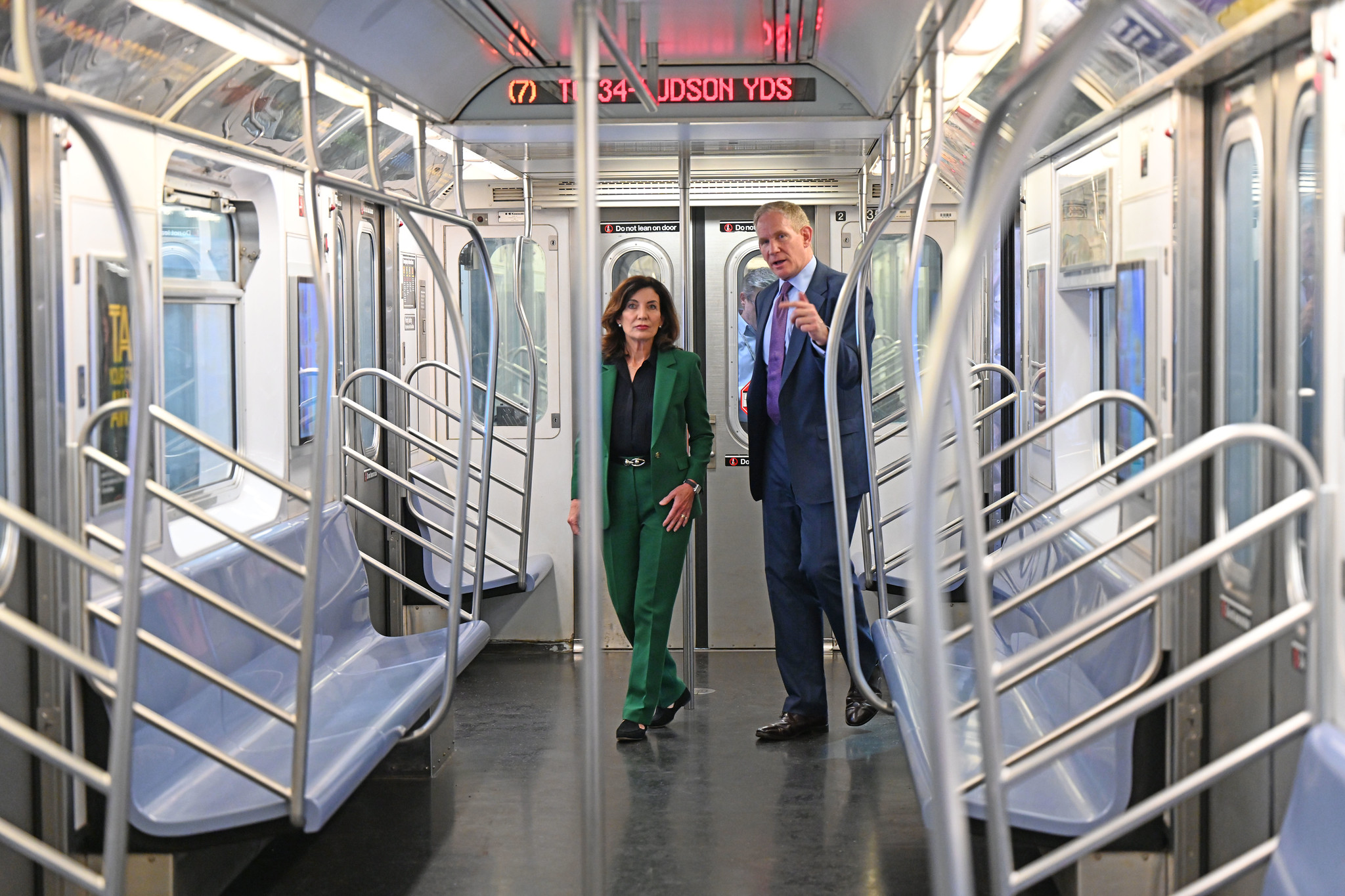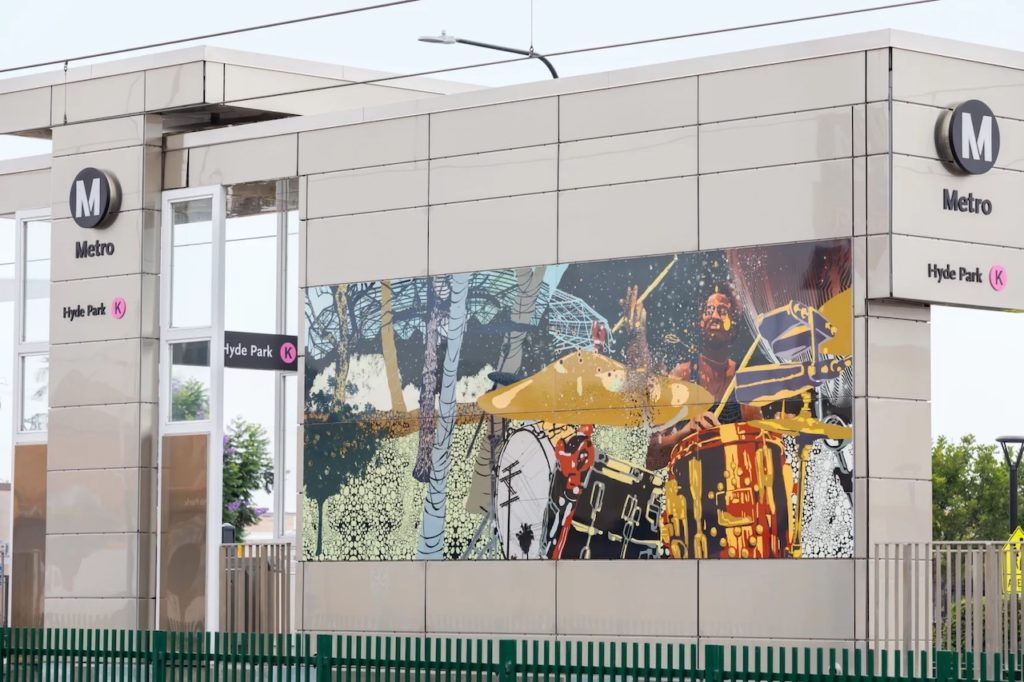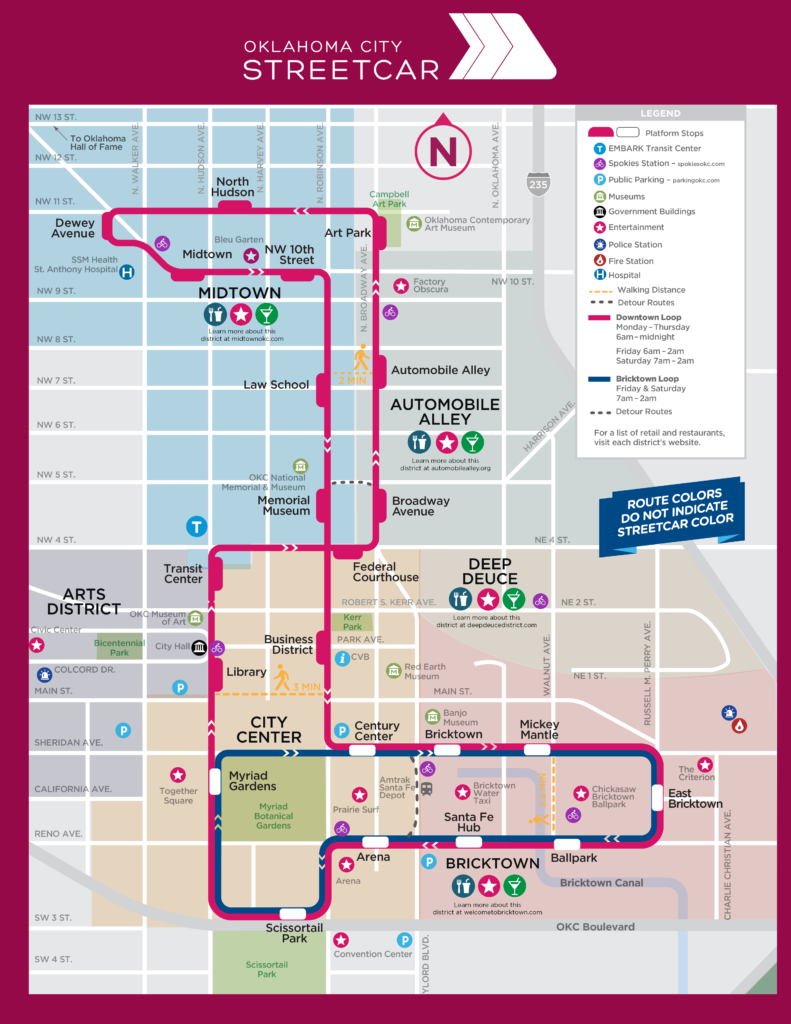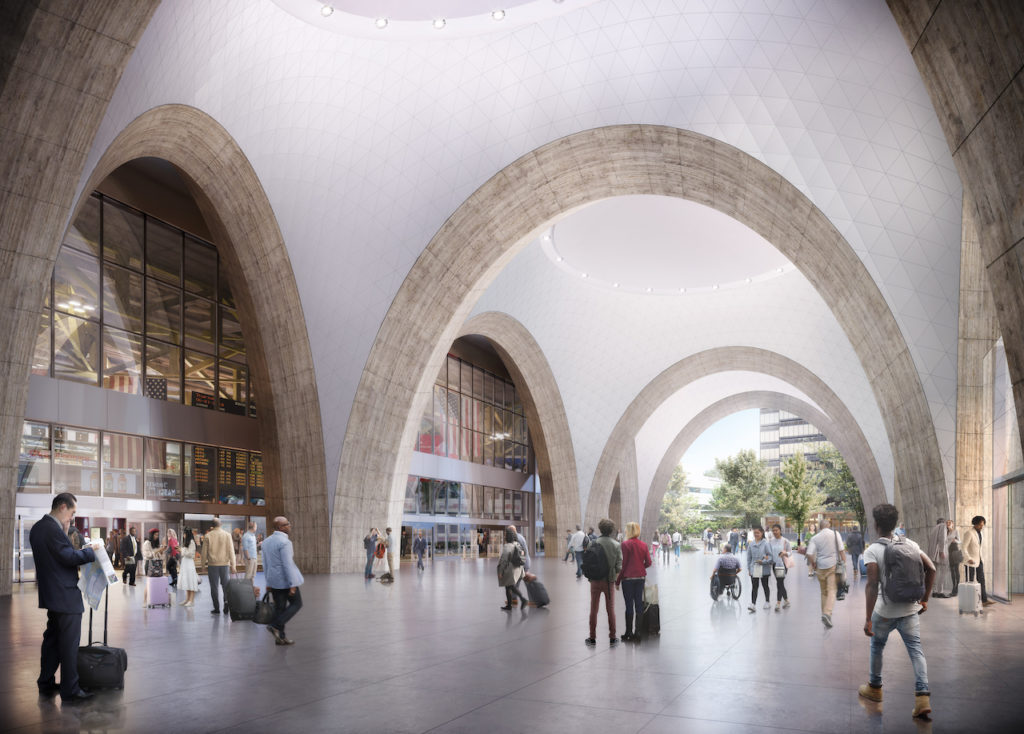
Transit Briefs: NYMTA, LA Metro, OKC Streetcar, RTD, Boston’s South Station, Metro-North, LIRR
Written by Carolina Worrell, Senior Editor
Gov. Hochul, MTA Chief Executive Officer Janno Lieber, and Demetrius Crichlow, Senior Vice President of NYCT Subways tour a 7 train with newly installed high- resolution security cameras at the Corona Maintenance Facility in Queens, Tuesday Sept. 20, 2022. Eventually, all 6,500-plus subway cars in the NYCT system will be outfitted with two high resolution video cameras to ensure safety for straphangers. (Kevin P. Coughlin / Office of Governor Kathy Hochul)
Metropolitan Transportation Authority (MTA) to install security cameras in every subway car. Also, LA Metro releases new photos of the K Line’s Hyde Park Station artwork; the OKC Streetcar reaches one million rider milestone; the Regional Transportation District (RTD) closes financial transaction reducing its annual debt service by more than $144 million over 200 years; officials celebrate the next chapter in the redevelopment of Boston’s South Station; and Metro-North Railroad and Long Island Rail Road (LIRR) will get their own police detail.
MTA
Gov. Kathy Hochul on Sept. 20 announced that MTA’s New York City Transit (NYCT) has received a $2 million award, through the Urban Area Security Initiative federal grant program, to provide funding for the installation of cameras across the entire fleet of subway cars, “enhancing security coverage, and, most importantly, increasing passenger confidence in mass transit safety.”
The Urban Area Security Initiative is a program under the U.S. Department of Homeland Security Preparedness Grants. The funding, MTA says, will enable the purchase of 5,400 cameras to be installed on 2,700 NYCT subway cars, two per car. Additionally, the program will fund approximately 3,800 cameras expanding coverage in approximately 130 subway stations.
According to the MTA, funding will further strengthen NYCT’s existing security network of more than 10,000 cameras across all 472 subway stations. The new funding covers the cost of camera installation on 6,355 cars, allowing the MTA to fully outfit every subway car with cameras—supplementing an existing camera pilot program that includes 200 cameras in 100 subway cars. Additionally, funding from the Subway Action Plan totaling $3.5 million will enable the purchase of 7,310 cameras on 3,655 cars, two per car. The total funding to complete the installations equals $5.5 million. When installation begins, MTA says, an additional 200 train cars per month will have cameras installed until the entire subway car fleet is camera-equipped, which is anticipated to occur sometime in 2025. In addition, when new R211 subway cars are delivered starting in early 2023 they will already be camera-equipped, MTA says.
According to the MTA, this is the latest measure Gov. Hochul has taken to deter crime and enhance the safety of New York City Subways. In June, Gov. Hochul signed legislation to protect roughly 11,000 more transit workers against assault and harassment. The legislation extended criminal charges to individuals who assault station customer assistants, ticket or revenue collectors, maintenance workers, repairers, cleaners, and their supervisors, who were not protected under previous laws.
“My number one priority as Governor is keeping New Yorkers safe,” Governor Hochul said. “I am proud that we will be installing cameras on all Subway cars – expanding our security capabilities, deterring crime, and providing our law enforcement with support. As we continue welcoming riders back to the transit system, we will continue doing everything in our power to keep riders safe.”
According to the MTA, all Metro-North trains are equipped with cameras, and more than 90% of LIRR trains are equipped with security cameras. Last year, camera installation across every subway station was accelerated and completed ahead of schedule. Two thousand cameras were installed in 2021 alone, MTA says.
“The MTA is committed to providing safe and reliable public transit and the Urban Area Security Initiative Award marks the latest step forward in the Authority’s mission to be a fully monitored transit system by better deterring crime and increasing passenger security,” MTA says.
LA Metro
At the future Hyde Park Station on the K Line, the Metro Art-commissioned artwork installed at the station’s entrance and platform celebrates the “vibrant culture, community and music of Hyde Park.”
According to Metro, the artwork, Hyde Park Oasis, which was created by artist Carlson Hatton, who was commissioned through an open competitive process following the recommendation of a panel of community-based arts professionals, is “a series of art panels layered with history and visions for the future shared by Hyde Park residents, small business owners and youth.”

Hyde Park Oasis, Metro says, is the culmination of many engaged public conversations, which brought together the artist and Hyde Park residents with deep community ties. Residents shared personally meaningful historical and cultural references and identified key imagery that represented their vision and knowledge of Hyde Park, all while Hatton listened.
An integral part of the design’s development, Metro says, was Hatton’s mentoring of four local student artists: Joshua Castro, Barbara Visconti, Felipe Garcia and Jarrid Godbold. Throughout the course of several years, they researched neighborhood references by sourcing and photographing imagery unearthed in the community conversations. Hatton then wove these images into the 10 densely layered paintings of Hyde Park Oasis.
Classic low-riders along Crenshaw Boulevard, live music gatherings, energetic social scenes, verdant gardens with fruit trees, mask festivals and the playing of hand-made African drums are all included, as are hundreds of patterns documented along Crenshaw. Music emerged as a key theme, too, with influential Crenshaw Corridor musicians and styles—from legendary drummer Robin Russell to contemporary jazz artists to the drum line tradition—all visible in the work.
With rhythmic patterns of color and wide skylines of majestic palm trees cresting notable buildings on the horizon, Hyde Park Oasis is “a tribute to Hyde Park and its soundtrack as it echoes across South Los Angeles,” Metro says.
These artworks, which are fabricated as durable porcelain enamel steel panels, are now visible on all sides of Hyde Park Station at Crenshaw Boulevard and Slauson Avenue.
Learn more about the artwork here.
Check out previous posts on the installed station artworks of the Crenshaw/LAX (K Line) Transit Art Program featuring videos on the K Line artists and artwork by filmmaker Mobolaji Olambiwonnu:
- Expo/Crenshaw Station: Erwin Redl
- Martin Luther King, Jr. Station: Shinique Smith
- Martin Luther King, Jr. Station: Mara Lonner
- Leimert Park Station: Ingrid Calame
- Leimert Park Station: Mickalene Thomas
- Downtown Inglewood Station: Kenturah Davis
Learn more about the Crenshaw/LAX (K Line) Transit Project, now K Line, Art Program here.
OKC Streetcar
OKC Streetcar announced on Sept. 16 that it reached its one million rider milestone on Saturday, Sept. 10, since service began in December 2018, according to EMBARK officials.
A 2009 voter-approved project of Oklahoma City’s Metropolitan Area Projects (MAPS) 3 program, OKC Streetcar “aims to strengthen community connections, support economic growth, and enhance mobility for residents and visitors in OKC’s core.” OKC Streetcar construction was completed in October 2018, and the service officially launched on Dec. 14, 2018, with fare collection beginning in February 2019. The streetcar includes two route options: the 4.8-mile Downtown Loop and the two-mile Bricktown Loop, and serves five Downtown OKC districts, including Automobile Alley, Bricktown, City Center, Arts District and Midtown.
OKC Streetcar is the region’s first local passenger rail in nearly a century, says EMBARK, the business unit of the Central Oklahoma Transportation & Parking Authority (COTPA), a public trust administered by the City of Oklahoma City. Now the Regional Transportation Authority (RTA) of Central Oklahoma is conducting federal studies to bring regional commuter rail service to Edmond, Oklahoma City, Norman, and Tinker Air Force base.
“I commend everyone at OKC Streetcar for working together to get through a two-year period that was very challenging across the country for public transit, downtowns and tourism,” said Oklahoma City Mayor David Holt. “As we transition into some normality, the Streetcar continues to emerge as a valuable resource for visitors, who are themselves an ever more important part of our local economy.”
Holt adds, “As we begin to welcome more aspects of a comprehensive transit system, including the RAPIDBus Rapid Transit line and the potential for commuter rail through RTA, we will begin to fully realize the important role that the Streetcar plays as a circulator for residents arriving downtown without a car.In the meantime, the Streecar has already spurred major economic development downtown, and in moving more an a million passengers, it has obviously already established itself as a desirable amenity.”
The first MAPS projects began on Dec. 14, 1993, when voters approved the first sales tax. MAPS for Kids was established in 2001 when voters approved a second MAPS tax, raising $700 million and benefitting public schools located in Oklahoma City.
Voters approved MAPS 3 on Dec. 8, 2009. The sales tax ran from April 2010 through December 2017. MAPS 4 was approved in 2019 and will raise a projected $1.1 billion over eight years, EMBARK says. MAPS 4 will “continue the transformation of Oklahoma City’s public transit system with $97 million dedicated to dramatic new improvements, including two Bus Rapid Transit lines and more than 500 bus shelters.”
“Continuing to build transportation that is accessible to all means greater opportunity for our future generations,” said Assistant City Manager and EMBARK Administrator Jason Ferbrache. “Today, the streetcar is a critical strategic element of our region’s transportation future—connecting with as many as three RAPID transit lines, dozens of bus routes, bike share, and the RTA’s visionary commuter rail network.”

RTD
RTD announced on Sept. 19 that in late August it closed a financial transaction that refinanced its FasTracks Series 2014 certificates of participation (COPs) with FasTracks bonds to lock in savings of more than $144 million in future interest expense over the next 22 years.
The transaction, authorized by RTD’s Board of Directors at its July 26 meeting, will “reduce its annual debt service by a significant amount through interest savings–on average, the net present value of the savings is approximately $6.5 million each year in today’s dollars,” the agency says. This reduction, RTD says, will increase future budgeting flexibility and help RTD continue to deliver valuable public transportation services to the community. RTD adds that it regularly looks for opportunities to decrease its financial obligations.
“This transaction is a consequential achievement and demonstrates thoughtful stewardship of public funds and fiscal accountability,” RTD General Manager and CEO Debra A. Johnson said.
Referencing the agency’s strategic plan, she added: “Our priority of financial success is paramount. We want to optimize the dollars we spend in the most efficient manner possible. With this transaction, we are making the most of taxpayer dollars for the betterment of the agency.”
The 2014 COPs were initially issued to provide part of the funding to build RTD’s newest commuter rail line, the N Line, which serves Denver, Commerce City, Northglenn and Thornton. These COPs were refinanced with $320 million in bond proceeds, proceeds from the 2014 COPs debt service reserves and $93.3 million of RTD cash, including $0.3 million for the cost of issuance, RTD says.
According to RTD, the refinancing used the approximately $350 million of remaining FasTracks sales tax bond borrowing capacity approved by voters in 2004. RTD says it used the remaining debt capacity with this transaction to “realize significant additional interest savings achieved through issuing bonds rather than COPs and to avoid any expiration of the voter authorization.”
Beyond reducing FasTracks’ outstanding debt and debt service, the refinancing, RTD says, also improves the agency’s ability to issue COPs to fund future projects. However, RTD adds that it has no current plans to issue additional debt and forecasts that ongoing district needs will be funded with cash.
Boston South Station
Privately-owned global real estate firm Hines on Sept. 20 was joined by Gov. Charlie Baker, Mayor Michelle Wu, Senator Lydia Edwards, and Chairman and State Representative Aaron Michlewitz to celebrate the beginning of the “highly anticipated” expansion and improvement of the Gov. Michael S. Dukakis Transportation Center at Boston’s South Station. The project, Hines says, is “notable for its significant private investment in the city’s transit hub, and the continuation of South Station’s history of being a regional transportation core and destination.”
Work on the 51-story, 1,020,000-square-foot building, which was developed and designed by global placemaker Pelli Clarke & Partners, began in January 2020 and will “redefine the Boston skyline,” Hines says.

Currently, the South Station train station and bus terminal are two separate buildings, making connections between them difficult and inconvenient. According to Hines, the completion of the South Station Transportation Center will create comfortable and convenient transfers between all modes of transit, with direct connections between the rail and bus terminals.
According to Hines, the new outdoor concourse area will increase in size by 67% for an improved experience for passengers and people passing through the station. The tracks and platforms will be covered, and the outdoor concourse will be transformed into an architecturally significant gateway to the city. The new bus terminal will increase capacity by more than 50% and will provide more convenient connections to the train and subway.
Hines says it has committed to supporting local employment opportunities, including at least 50% of the total work hours benefitting Boston residents; at least 25% of the total work hours will benefit people of color; and at least 10% of the total work hours benefiting female workers. Construction is being privately funded and, along with creating a new public space at the train station concourse, it will also improve the streetscape along Atlantic Avenue with new sidewalks, granite curbs, streetlights, greenery and street furniture, “further activating the area and resulting in a vibrant, safe and welcoming experience for all.”
In addition to transit and station improvements, Hines says the development will deliver a state-of-the-art office and residential tower positioned directly above South Station. Anticipated for delivery in 2025, the first phase of the project will offer approximately 670,000 rentable square feet of Class A office and amenity space, as well as approximately 166 luxury residential condominium units and more than 500 parking spaces.
The office component will feature 29,000 square feet, primarily column-free, floor plates with 13 feet floor-to-ceiling heights and unobstructed views of downtown Boston and Boston Harbor. The residential component of the tower will offer studio, one-, two- and three-bedroom residences along with penthouse duplex homes. Office tenants and residents will be provided with market-leading amenities such as a large park situated on top of the parking garage; conference center; fitness and wellness center, a restaurant and landscaped terrace with a swimming pool and dining and entertaining space for resident use on the 36th floor.
Strategically located at the nexus between Boston’s Central Business District and the rapidly growing Seaport District, Hines says the property has convenient access to Logan International Airport, as well as the area’s primary highways, including Interstate 93 and the Massachusetts Turnpike.
The building is designed to achieve LEED Gold certification, WELL Gold certification and to be one of the first BREEAM “Excellent” ratings in the U.S.
Metro-North Railroad/LIRR
According to a WSHU report, starting in January, Metro-North Railroad and LIRR will have a dedicated unit of police officers ride the commuter rail system to “address growing safety concerns of riders and employees.”
According to the report, riders surveyed in August gave the LIRR its lowest marks for safety, crime and quality of life. Major crimes on the LIRR were up by 73% through August, including theft and violent crimes against riders and employees.
“These are true victims,” MTA Police Commissioner John Mueller said. “These are people that have to go home and then they have to come back to work a lot of the time traumatized. So, we’re going to be watching this very carefully. And we’re going to be advocating for consequences.”
According to the report, Mueller told the MTA Board during Monday’s meeting the train patrol unit will be deployed with 60 existing officers, following routes to stations with the most ridership.
Last week, the MTA announced record ridership numbers for the commuter rail system, back to pre-pandemic levels. Metro-North Railroad set a ridership record, carrying more than 181,600 riders, the highest since at least March 2020. LIRR carried more than 200,000 riders on a weekday for the second time since March 2020. Its record was set earlier in the month since COVID.
The creation of the new unit will be “cost neutral” to the department, according to the MTA, because it uses existing officers, WSHU reported. The MTA police force, with about 1,100 officers, stepped up patrols of LIRR trains earlier this year to combat rising crime. The transit agency has hired 500 additional officers since 2019.
According to the report, with more commuters on the rails, Mueller said more officers and canines on the platform and trains will keep everyone safe. Starting at 5 a.m., officers will start on either side of the train platform, get on trains and walk to the middle car, while interacting with riders.
“The goal is to be highly visible to deter crime,” Mueller said. “We want a lot of rider interaction with the officers,” he added.



